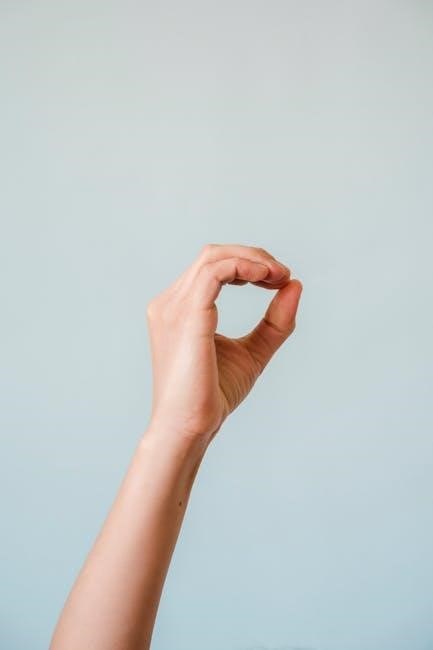hand hand fingers thumb pdf

Anatomy and Physiology of Hand, Fingers, and Thumb
The human hand consists of 14 bones in the fingers and 5 metacarpal bones in the palm. Each finger has three phalanges, while the thumb has two, enabling precise movement. The structure allows for flexibility and dexterity, essential for daily activities and complex tasks.
Structure of Fingers and Thumb
The human hand is composed of 14 bones in the fingers and 5 metacarpal bones in the palm. Each finger contains three phalanges (proximal, middle, and distal), while the thumb has only two (proximal and distal). This structure allows for flexibility and precise movement. The thumb, often referred to as the pollex, differs from other digits in shape and function, enabling opposition and grasping. The metacarpal bones connect the fingers to the wrist, forming the palm’s framework. This anatomical design ensures dexterity, making the hand a vital tool for daily activities and complex tasks.
Phalanges and Joints
The fingers and thumb are composed of phalanges, small bones that form the framework of each digit. Each finger contains three phalanges (proximal, middle, and distal), while the thumb has two (proximal and distal). These bones are connected by joints that allow for flexion, extension, and limited rotation. The metacarpophalangeal joints connect the phalanges to the metacarpal bones in the palm, enabling a wide range of motion. The interphalangeal joints link the phalanges within each finger, facilitating precise movements. The thumb’s unique joint structure allows for opposition, a key feature distinguishing it from other digits. This intricate arrangement of bones and joints enables dexterity and precise manipulation, making the hand a vital tool for daily activities and complex tasks;

Medical Research and Studies
Research highlights advancements in restoring finger function, recovery from injuries, and surgical innovations like digit pollicization. Studies focus on optimizing hand and thumb surgeries for improved outcomes and functionality.
Recovery from Injuries and Trauma
Recovery from hand, finger, and thumb injuries requires meticulous care and rehabilitation. Studies emphasize the importance of early intervention to restore functionality and prevent long-term impairments. Surgical techniques, such as digit pollicization, have shown success in reconstructing thumbs, enabling patients to regain essential grip and dexterity. Researchers highlight the effectiveness of toe-to-hand transplantation in children, addressing congenital or traumatic hand pathologies. Post-traumatic recovery often involves optimizing finger replacement, ensuring adequate blood supply and tissue integrity. Vascular anatomy plays a critical role in these surgeries, as detailed in recent medical literature. The goal is to restore both form and function, allowing individuals to resume daily activities and maintain independence. Advances in surgical precision and rehabilitation protocols continue to improve outcomes, offering hope for full recovery in even severe cases.
Vascular Anatomy in Fingers and Thumb
The vascular anatomy of the fingers and thumb is intricate, with third-order vessels playing a crucial role in supplying blood to each phalange. These vessels are essential for maintaining tissue integrity and enabling precise movements. Recent studies have analyzed the anatomy of these vessels and their surrounding tissues, highlighting their significance in surgical procedures. Proper blood flow is vital for healing and functionality, particularly after injuries or surgeries like digit pollicization. Understanding this vascular network aids in optimizing surgical techniques, such as toe-to-hand transplantation, ensuring successful revascularization. The thumb, with its unique structure, relies on a distinct vascular supply that differs from the fingers. This knowledge is critical for restoring function and preventing complications in hand trauma cases.

Exercises and Rehabilitation
Gentle exercises improve finger and thumb range of motion, reducing arthritis symptoms and enhancing functionality. Regular hand workouts maintain independence and overall hand health effectively.
Hand, Finger, and Thumb Workouts
Hand, finger, and thumb workouts are essential for maintaining dexterity and strength. Gentle exercises, such as finger bends, thumb stretches, and finger spreads, improve range of motion and reduce stiffness. Regular hand workouts can enhance functionality, especially for individuals with arthritis. Using light weights or resistance bands can strengthen the muscles of the hand and forearm. Additionally, exercises like thumb opposition and finger extensions help maintain independence in daily activities. These workouts are simple yet effective, promoting overall hand health and preventing mobility loss. Incorporating these exercises into a daily routine ensures long-term hand function and well-being.

Managing Arthritis through Exercise
Exercise plays a crucial role in managing arthritis, particularly in the hands, fingers, and thumb. Gentle workouts, such as finger bends, thumb stretches, and finger spreads, can improve joint mobility and reduce stiffness. Low-impact activities like yoga or swimming are highly recommended, as they minimize strain while promoting flexibility. Strengthening exercises, such as using light resistance bands, can enhance hand function and reduce pain. Consistency is key, as regular exercise helps maintain independence in daily tasks. Additionally, incorporating exercises that focus on thumb opposition and finger dexterity can prevent further decline in hand function. These routines are often detailed in hand, finger, and thumb workout guides, providing structured plans for arthritis management. By adhering to these exercises, individuals can effectively manage arthritis symptoms and preserve hand health.
Cultural and Educational Resources
Engaging children’s books like Hand, Hand, Fingers, Thumb by Al Perkins and Dr. Seuss’s playful rhymes make learning about hands, fingers, and thumbs fun and interactive for young readers.
Children’s Books on Hand, Fingers, and Thumb
Engaging children’s books, such as Hand, Hand, Fingers, Thumb by Al Perkins, offer a playful and rhythmic introduction to the anatomy and functions of hands, fingers, and thumbs. These books feature colorful illustrations and simple rhymes, making complex concepts accessible to young readers. Dr. Seuss’s contributions also highlight the importance of hands and fingers in daily activities, using whimsical storytelling to captivate children. Many of these books are available in PDF formats, allowing easy access for parents and educators. They are designed for toddlers and preschoolers, promoting early learning and motor skill development. The use of dancing monkeys and musical themes in these stories makes learning about hands, fingers, and thumbs both fun and memorable. These resources are invaluable for fostering curiosity and creativity in children while teaching them about their bodies.
Rhyming Texts for Learning
Rhyming texts are a powerful tool for engaging young learners in understanding the structure and function of hands, fingers, and thumbs. Books like Hand, Hand, Fingers, Thumb by Al Perkins use rhythmic patterns and simple language to make complex anatomical concepts accessible. These stories often feature repetitive phrases and catchy melodies, which aid in memory retention and language development. The integration of music and movement, such as drumming with hands and fingers, further enhances the learning experience. PDF versions of these texts are widely available, offering convenient access for parents and educators. Rhyming stories not only educate children about their bodies but also foster a love for reading and creative expression. By combining fun and learning, these resources provide a foundation for understanding the essential role of hands in daily activities.

Surgical Techniques and Innovations
Digit pollicization and toe-to-hand transplantation are innovative surgeries that restore thumb function and finger mobility in cases of congenital or traumatic hand defects, improving dexterity and independence.
Digit Pollicization Surgery
Digit pollicization surgery involves creating a functional thumb from an existing finger, typically the index finger, to restore grasping ability in cases of congenital thumb absence or severe trauma. This complex procedure requires precise surgical techniques to reshape and reposition the selected digit, ensuring proper alignment and mobility. The surgery involves rotating the index finger, attaching it as a thumb, and connecting nerves, tendons, and blood vessels. This innovative approach significantly improves hand function, enabling activities like gripping and pinching. The procedure is often performed on children with thumb deficiencies, offering long-term benefits for dexterity and independence. Surgeons use advanced methods to ensure the new thumb blends aesthetically and functionally with the rest of the hand, making it a life-changing intervention for individuals with hand anomalies.
Toe-to-Hand Transplantation

Toe-to-hand transplantation is a surgical procedure where toes are transferred to the hand to restore functionality in cases of severe finger or thumb loss. This innovative technique is particularly beneficial for individuals with congenital hand deformities or those who have suffered traumatic injuries. The procedure involves transplanting one or more toes, along with their associated nerves, blood vessels, and tendons, to the hand. The goal is to recreate a functional thumb or fingers, enabling activities like grasping, pinching, and fine motor tasks. Studies have demonstrated the effectiveness of this approach in children, showing improved hand function and dexterity. The transplantation process is complex, requiring meticulous surgical precision to ensure proper alignment and nerve reconnection. This method offers hope for individuals seeking to regain independence and improve their quality of life through restored hand function.

Importance and Maintenance of Hand Function
Hand function is crucial for daily activities, enabling tasks like grasping and manipulating objects. Regular exercises improve range of motion, reducing arthritis symptoms and maintaining independence.
Role in Daily Activities
Hands, fingers, and thumbs play a vital role in daily activities, enabling tasks like writing, cooking, and using tools. The thumb’s opposition to fingers allows precise gripping, while finger dexterity facilitates intricate movements. Cultural practices, such as counting on fingers, highlight their universal importance. Effective hand function is essential for independence, with impairments potentially limiting daily performance. Regular maintenance through exercise can prevent issues like arthritis, ensuring continued ability to engage in essential and enjoyable activities. The intricate anatomy and physiology of hands make them indispensable for both functional and creative pursuits, underscoring the need for proper care and maintenance to sustain their role in daily life.
Preventive Care and Health
Preventive care for hands, fingers, and thumbs involves regular exercise to maintain flexibility and strength. Stretching exercises can enhance range of motion, reducing the risk of injuries. Protecting hands from repetitive strain and heavy use is crucial to prevent conditions like arthritis or tendonitis. Proper ergonomics in workplaces and during daily activities can minimize stress on hand structures. Good hygiene practices also prevent infections, especially after injuries. Regular health check-ups can identify early signs of hand-related issues, allowing timely intervention. This proactive approach ensures optimal hand function, essential for daily tasks and overall well-being.



Leave a Reply
You must be logged in to post a comment.